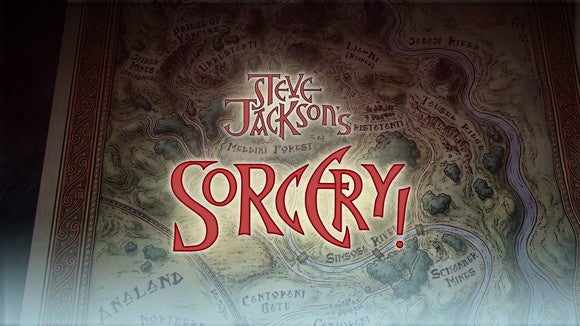
I’ve fought an assassin. I’ve saved an orcish princess. I’ve clambered through overflowing sewers. I’ve died from drinking too much river water, and died again from contracting plague. I’ve fought monsters, eaten rations, and rested at more inns than I’d care to recall. I’ve even—don’t tell anyone—thrown rocks at a little girl in exchange for an apple. (It wasn’t one of my prouder moments.)
This is Steve Jackson’s Sorcery! reimagined for 2016. And it’s also the latest from Inkle, creator of the acclaimed 80 Days.
I’ll put a spell on you
The Steve Jackson’s Sorcery! saga is actually pretty strange. Older readers might remember a series of identically-titled adventure gamebooks from the 1980s, of which this is a video game adaptation. And if you’re under the age of 30, that sentence probably sounds like gibberish.
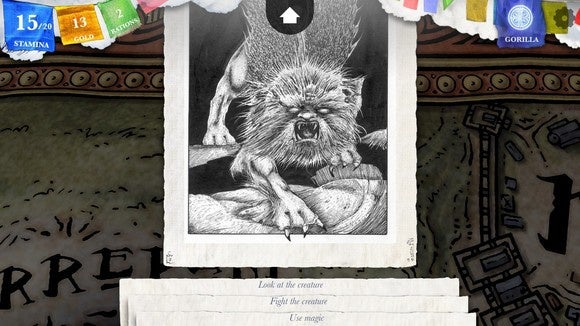
The best explanation I can come up with: Adventure gamebooks were more complicated than your standard choose-your-own-adventure, but less detailed than a full pen-and-paper role-playing game like Dungeons & Dragons. Instead, they drew from aspects of both—the branching novel format of the CYOA, and the combat/dice rolls/spellcasting/et cetera of D&D.
I’m probably not doing the concept justice, given I never owned any. However, if you’re interested I highly recommend you check out the Internet Archive’s collection.
Regardless, Inkle’s now adapted (or at least started to adapt) the Sorcery books to digital form, fleshing them out in the process. And the result, much like the gamebooks of old, is one part choose-your-own-adventure, one part role-playing game.
You begin your adventure in the realm of Analand and the Shamutanti Hills. Your character is represented as a little black-and-white pawn, flat on a storybook map. There are three basic actions: You drag your pawn forward to the next story beat, you make choices within those story beats, and sometimes those beats lead to combat.
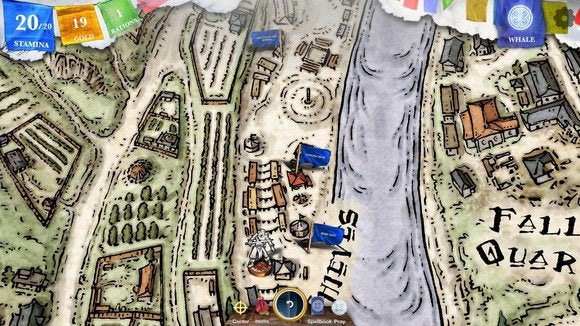
Beats are represented on the map by little blue flags, demarcated with short descriptions—“Sit by the river” or “Escape!” or “Camp outside.” These represent your high-level choices in Sorcery, what steps you take on your journey.
And there are a lot of them, many of which are mutually exclusive. Your path is your path, but just like 80 Days there are an incredible number of deviations, and deviations built upon deviations—plot points that only came up later in the game because I’d already made certain choices earlier on. Former-enemies turned friends, villages saved, witches befriended. Whatever path you choose, you’re going to miss out on a lot of what Sorceryhas to offer.
Those are just the macro choices. Once you’ve dragged your pawn to your next beat-of-choice, you get into the meat of Sorcery: Huge swathes of text, broken up occasionally with hand-drawn pictures I assume were included in the original books. Here, you’re bombarded with much smaller decisions—whether to flee or approach the old beggar sitting on the side of the road, whether to try and befriend a town full of silent and fearful people or just flee. Thousands of choices. Maybe hundreds of branches.
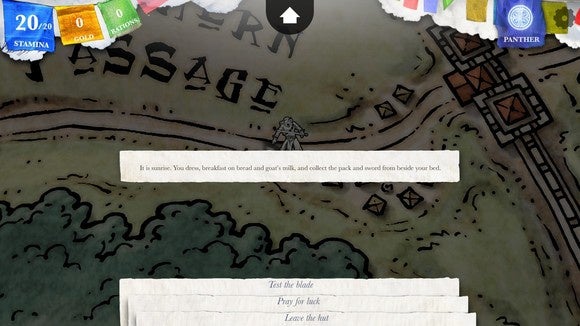
Your ultimate goal? To cross the world, to confront monsters and witches and assassins and various other ne’er-do-wells, to avoid traps and thieves, and to eventually reclaim the Crown of Kings for Analand—a powerful artifact that has fallen into the wrong hands.
If this all sounds very cliched-1980s-fantasy-novel, well, remember the source material.
Yet the characters, the dialogue, the scenarios contained therein are so compelling it manages to elevate Sorcery above its base premise. I don’t know how much to attribute to Steve Jackson and how much to the wordsmiths at Inkle, but Sorcery is full of intrigue.
For instance: I came across a cabin, far out in the woods, a day’s walk away from the nearest town. Upon arriving, an old woman smiled at me and asked me to stay for tea. Wary of the fact she might be a witch, I said I’d love tea—but I’d prefer to sit outside. She said that was fine and poured us two cups. We chatted for a while, when she got up to go inside and check on something. Quick as I could, I swapped her cup and mine (which I’d managed to avoid drinking from up until now).
She came back out, I took a sip from my cup and—ack, poison. She laughed, at once both amused and angry that I suspected her of being evil. Then she cured me and sent me on my way.
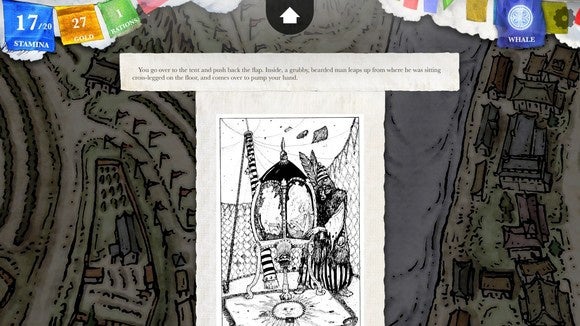
But if you ever read a choose-your-own-adventure as a kid (or as an adult!), you know part of the fun was keeping your finger pressed between the pages, ready to flip back and take the other option if things didn’t go your way. Inkle actually builds this into Sorcery, allowing you to “Rewind” to any story beat in your adventure and make a different choice—be it because you died or because you simply want to see a different outcome.
I used this feature sparingly, but curiosity did admittedly get the best of me at times. The witch, for instance. Rewinding allowed me to jump back, to see what would have happened had my suspicious nature not got the best of me. As it turns out she…well, maybe I should let you find out for yourself.
Is it unfair to rewind? Cheating? Yeah, maybe. But it also made me weirdly nostalgic for the worn-out choose-your-own-adventures I had as a kid, pages all dog-eared where I’d marked “BIG MOMENTS” to revisit. It’s an amazing confluence of source material and adaptation.
And the Rewind feature is necessary at times, given that death waits behind quite a few of Sorcery’s blue flags.
Combat can usually be tackled one of two ways—with sword or with spells. The sword is self-explanatory: Hack hack hack away at enemies until they’re dead or unconscious or whatever the story calls for. Swordplay in Sorcery is governed by a meter. You commit a certain amount of energy to each attack, and you want your number to be higher than your opponent’s. Both you and your opponent then regenerate a bit of energy each turn. It’s not too hard, but you’ll want to master mitigating damage if you plan to get in a lot of fights, as healing items or opportunities are few and far between.
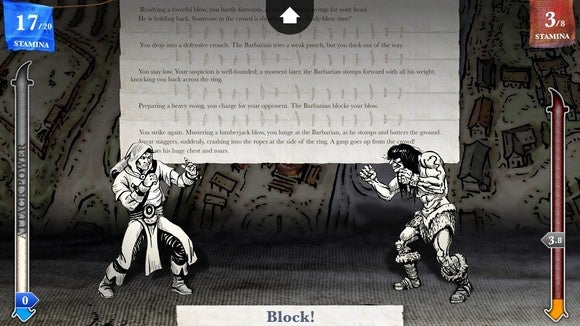
Much more interesting (and more broadly applicable) is the game’s spell system. The original Sorcery books had a spell list you were supposed to memorize. Each spell was a three-letter “word” like ZAP (an electrical attack) or DIM (make enemies stupid).
Inkle adapts this into a cloud of letters, accessible whenever the “CAST A SPELL!” choice is available—which is actually quite often. You then can tinker, putting three-letter words together to find something viable. (Or you could actually memorize all 48 spells, if you’re a wunderkind.) My favorite and the one I’ve gotten the most use from is BIG, which predictably turns your character into a temporary giant and has led to all sorts of hilarious situations.
Like 80 Days, Sorcery isn’t particularly long—maybe two or three hours per episode—but it’s also similarly replayable, and I’m planning to head back through at least once to see what I missed. (Plus, it’s pretty damn cheap.)
Bottom line
Inkle is fast becoming one of my favorite studios. 80 Days was excellent. Sorcery is much the same, forsaking the off-kilter Victorian Age for a more cliched land of swords and spells and knavery—and yet, by some combination of Inkle’s own talents and Steve Jackson’s original source, managing to wring some truly compelling ideas from the game’s thin sword-and-board pretenses.
And I’ve still got two more adventures ahead before Sorcery wraps up. Fantastic.
NOTE: At the moment, only the first two parts (based off the first two books) of Sorcery are on PC. Part three is already on mobile and is headed for PC shortly. Part four is slated to hit every platform simultaneously later this year. We do not assign review scores to episodic games until they’re released in full.
[“source -pcworld”]




